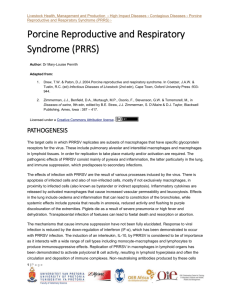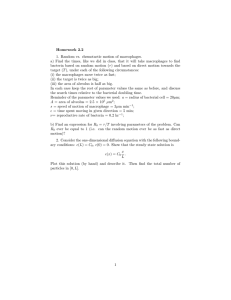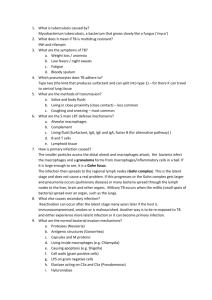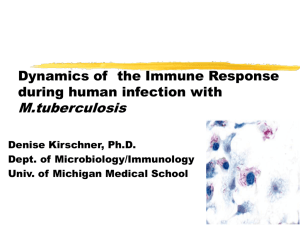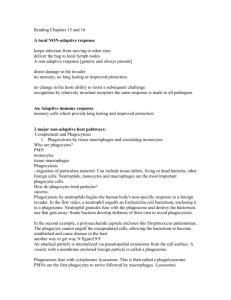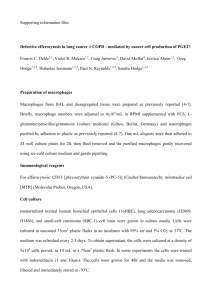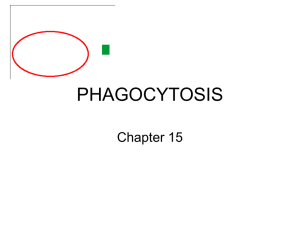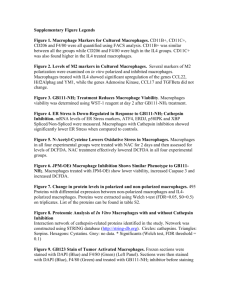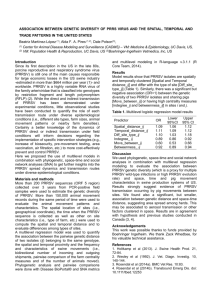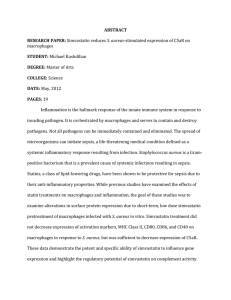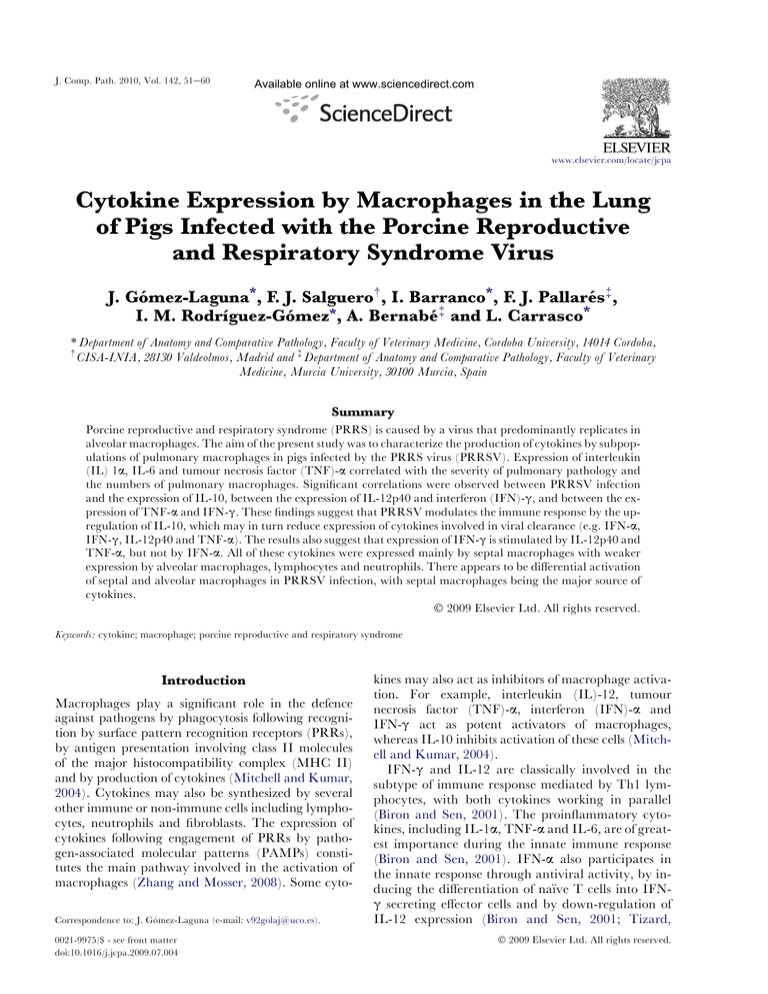
J. Comp. Path. 2010, Vol. 142, 51e60
Available online at www.sciencedirect.com
www.elsevier.com/locate/jcpa
Cytokine Expression by Macrophages in the Lung
of Pigs Infected with the Porcine Reproductive
and Respiratory Syndrome Virus
J. Gómez-Laguna*, F. J. Salguero†, I. Barranco*, F. J. Pallarés‡,
I. M. Rodrı́guez-Gómez*, A. Bernabé‡ and L. Carrasco*
* Department of Anatomy and Comparative Pathology, Faculty of Veterinary Medicine, Cordoba University, 14014 Cordoba,
†
CISA-INIA, 28130 Valdeolmos, Madrid and ‡ Department of Anatomy and Comparative Pathology, Faculty of Veterinary
Medicine, Murcia University, 30100 Murcia, Spain
Summary
Porcine reproductive and respiratory syndrome (PRRS) is caused by a virus that predominantly replicates in
alveolar macrophages. The aim of the present study was to characterize the production of cytokines by subpopulations of pulmonary macrophages in pigs infected by the PRRS virus (PRRSV). Expression of interleukin
(IL) 1a, IL-6 and tumour necrosis factor (TNF)-a correlated with the severity of pulmonary pathology and
the numbers of pulmonary macrophages. Significant correlations were observed between PRRSV infection
and the expression of IL-10, between the expression of IL-12p40 and interferon (IFN)-g, and between the expression of TNF-a and IFN-g. These findings suggest that PRRSV modulates the immune response by the upregulation of IL-10, which may in turn reduce expression of cytokines involved in viral clearance (e.g. IFN-a,
IFN-g, IL-12p40 and TNF-a). The results also suggest that expression of IFN-g is stimulated by IL-12p40 and
TNF-a, but not by IFN-a. All of these cytokines were expressed mainly by septal macrophages with weaker
expression by alveolar macrophages, lymphocytes and neutrophils. There appears to be differential activation
of septal and alveolar macrophages in PRRSV infection, with septal macrophages being the major source of
cytokines.
Ó 2009 Elsevier Ltd. All rights reserved.
Keywords: cytokine; macrophage; porcine reproductive and respiratory syndrome
Introduction
Macrophages play a significant role in the defence
against pathogens by phagocytosis following recognition by surface pattern recognition receptors (PRRs),
by antigen presentation involving class II molecules
of the major histocompatibility complex (MHC II)
and by production of cytokines (Mitchell and Kumar,
2004). Cytokines may also be synthesized by several
other immune or non-immune cells including lymphocytes, neutrophils and fibroblasts. The expression of
cytokines following engagement of PRRs by pathogen-associated molecular patterns (PAMPs) constitutes the main pathway involved in the activation of
macrophages (Zhang and Mosser, 2008). Some cytoCorrespondence to: J. Gómez-Laguna (e-mail: v92golaj@uco.es).
0021-9975/$ - see front matter
doi:10.1016/j.jcpa.2009.07.004
kines may also act as inhibitors of macrophage activation. For example, interleukin (IL)-12, tumour
necrosis factor (TNF)-a, interferon (IFN)-a and
IFN-g act as potent activators of macrophages,
whereas IL-10 inhibits activation of these cells (Mitchell and Kumar, 2004).
IFN-g and IL-12 are classically involved in the
subtype of immune response mediated by Th1 lymphocytes, with both cytokines working in parallel
(Biron and Sen, 2001). The proinflammatory cytokines, including IL-1a, TNF-a and IL-6, are of greatest importance during the innate immune response
(Biron and Sen, 2001). IFN-a also participates in
the innate response through antiviral activity, by inducing the differentiation of na€ıve T cells into IFNg secreting effector cells and by down-regulation of
IL-12 expression (Biron and Sen, 2001; Tizard,
Ó 2009 Elsevier Ltd. All rights reserved.
52
J. Gómez-Laguna et al.
2008). In contrast, IL-10 is considered to be an immunosuppressive cytokine as it down-regulates the expression of several other cytokines including IL-1a,
TNF-a, IL-6, IL-10 itself, IL-12 and IFN-g (Biron
and Sen, 2001; Moore et al., 2001).
Porcine reproductive and respiratory syndrome
(PRRS) is one of the most economically significant diseases of the swine industry (Neumann et al., 2005). The
syndrome is characterized by interstitial pneumonia in
growing pigs and reproductive failure in gilts (Rossow,
1998). PRRS is caused by a positive-strand enveloped
RNA virus, known as PRRS virus (PRRSV), which
belongs to the family Arteriviridae in the order Nidovirales (Fauquet et al., 2005). PRRSV replicates
mainly in porcine alveolar macrophages and, to a lesser
extent, in monocytes and dendritic cells (Molitor et al.,
1997; Bautista and Molitor, 1999).
Several studies have examined the role of cytokines
in the pathogenesis of PRRS (Van Reeth and Nauwynck, 2000); however, it is not clear how cytokines
participate in macrophage activation during PRRSV
infection or how they regulate development of the immune response to the virus. Thanawongnuwech et al.
(2003) suggested that expression of IFN-g by macrophages and lymphocytes may have an inhibitory effect on the replication of PRRSV. Another study of
a PRRSV modified-live vaccine has shown that upregulation of IL-10 expression is associated with
a lower number of IFN-g secreting cells amongst peripheral blood mononuclear cells (PBMCs) (Dı́az
et al., 2006).
The role of cytokines in the interstitial pneumonia
described in PRRS has not yet been determined. Accordingly, the aim of the present study was to characterize the production of cytokines by subpopulations of
pulmonary macrophages in pigs infected by PRRSV.
Materials and Methods
Virus, Animals and Experimental Design
Thirty-two specific pathogen free, 5-week-old pigs
from a PRRSV seronegative farm were used in this
study. Twenty eight animals were randomly assigned
to groups of four and inoculated by the intramuscular
route with 1 ml of the third passage of PRRSV field
isolate 2982 (kindly provided by Dr. E. Mateu) at
103.0 TCID50. The virus was initially isolated in porcine alveolar macrophages from the serum of naturally infected piglets during a respiratory outbreak
of PRRS affecting a Spanish farm. This field isolate
has an open reading frame-5 sequence similarity of
93% with Lelystad virus (GenBank accession number
EF429108). The inoculated animals were killed at 3,
7, 10, 14, 17, 21 and 24 days post-inoculation (dpi).
Another group of four pigs were sham-inoculated controls. These animals were injected intramuscularly
with 1 ml of sterile RPMI 1640 medium and killed
at the end of the study (24 dpi). All animals were sedated with tiletamine-zolazepam (ZoletilÔ; Virbac,
Barcelona, Spain) followed by a lethal dose of 5% sodium thiopental (ThiovetÔ; Vet Limited, Leyland,
Lancashire). The experiment was carried out according to the guidelines of the European Union (Directive 86/609/EEC) and was approved by the local
ethical committee of Centro de Investigación en Sanidad Animal (CISA-INIA; Valdeolmos, Madrid,
Spain).
Clinical Signs, Gross Pathology and Pulmonary
Histopathology
The pigs were monitored daily for clinical signs, including rectal temperature and a clinical respiratory
score, as previously described (Halbur et al., 1995).
During post-mortem examination, gross lung lesions
were evaluated by visual inspection and each lung
lobe was scored to reflect the approximate volume
or percentage of the lung tissue affected (Halbur
et al., 1995). Samples from the medial lobe of the right
lung were fixed in 10% neutral buffered formalin and
in Bouin’s solution, processed routinely and embedded in paraffin-wax. Sections (4 mm) of formalinfixed tissue were stained with haematoxylin and eosin
(HE) for microscopical examination.
Immunohistochemistry (IHC)
Since PRRSV is most frequently detected in the apical and medial lung lobes (Halbur et al., 1996), the
medial lobe was selected for immunohistochemical
examination. The avidinebiotineperoxidase complex technique (ABC) was used for the detection of
PRRSV, macrophages and cytokine proteins as described previously (Hsu et al., 1981). Formalin-fixed
tissue was used for detection of macrophages and tissue fixed in Bouin’s solution for all other immunohistochemical reactions. Briefly, the sections were
dewaxed and dehydrated through graded ethanol
and the endogenous peroxidase activity was
quenched in H2O2 3% in methanol for 30 min. The
sections were washed with phosphate buffered saline
(PBS; pH 7.4, 0.01 M) and incubated for 30 min at
room temperature with 100 ml per slide of blocking solution in a humid chamber. Table 1 describes the primary antibodies and antigen retrieval methods
applied. Primary antibodies were incubated overnight at 4 C in a humid chamber. In each case the
corresponding biotinylated secondary antibody was
incubated for 30 min at room temperature. An
53
Cytokine Expression in PRRSV Infection
Table 1
Summary of immunohistochemical methodology
Specificity
Type of antibody
Source
Commercial origin
Fixative
Dilution
Antigen retrieval
PRRSV (clone
SDOW-17/SR-30)
Human macrophages
(clone MAC387)
Human IL-1a
mAb
Mouse myeloma
cells
NS1 Mouse myeloma
cell line
Rabbit serum
Bouin’s
1 in 1,000
HTAR
Formaldehyde
10%
Bouin’s
1 in 750
Protease
1 in 100
Tween
Porcine IL-6
Human TNF-a
(clone 68B6A3)
Porcine IFN-a
(clone F17)
pAb
mAb
Bouin’s
Bouin’s
1 in 10
1 in 25
Tween
Tween
Bouin’s
1 in 300
Tween
Porcine IFN-g
pAb
Goat serum
Bouin’s
1 in 20
Tween
Porcine IL-10
Porcine IL-12
pAb
pAb
Goat serum
Goat serum
Rural Technologies
Inc.
Chemicon Europe,
Hampshire, UK
Endogen, Woburn,
Massachusetts
Endogen
Biosource, Camarillo,
California
Prof. K. Van Reeth,
University of Ghent,
Belgium
RnD Systems,
Minneapolis,
Minnesota
RnD Systems
RnD Systems
Bouin’s
Bouin’s
1 in 20
1 in 20
Tween
Tween
mAb
pAb
mAb
Rabbit serum
NSO Mouse myeloma
cell line
Mouse myeloma
cells
mAb, monoclonal antibody; pAb, polyclonal antibody; HTAR, high temperature antigen retrieval with citrate buffer pH 6.0; Protease, protease
digestion for 10 min; Tween, incubation in Tween 20 diluted 0.01% in phosphate buffered saline for 10 min.
avidineperoxidase complex (Vector Laboratories,
Burlingame, California) was applied for 1 h at room
temperature. Labelling was ‘visualized’ by application of the NovaREDÔ substrate kit (Vector Laboratories). Sections were counterstained with Mayer’s
haematoxylin, dehydrated and mounted. For negative controls, the primary antibody was replaced by
blocking solution, normal serum and isotypematched reagents of irrelevant specificity.
the presence of lung lesions and the expression of
virus, macrophages and cytokines was assessed by
the Spearman test (GraphPad Instat 3.05). P < 0.05
was considered to represent a statistically significant
difference.
Cell Counting
Control animals did not display clinical signs or significant gross or microscopical lung lesions. Although inoculated animals displayed no significant respiratory
distress, they did develop dullness, weight loss and
mild hyperthermia from 3 dpi. From 7 dpi until the
end of the study, almost 50% of the pulmonary parenchyma of the inoculated animals was affected by interstitial pneumonia, and this was confirmed by
microscopical examination of the tissue samples
(Figs. 1A, 2A).
The number of labelled cells was determined as described previously (Salguero et al., 2005). Briefly,
the labelled cells were counted in 50 non-overlapping
and consecutively selected high magnification fields of
0.20 mm2. Results are expressed as the number of cells
per mm2. Immunolabelled cells were identified and
counted morphologically as macrophages, lymphocytes or neutrophils. Pulmonary intravascular macrophages and interstitial macrophages were grouped
together and described as ‘septal macrophages’.
Statistical Analysis
The numbers of macrophages, PRRSV-infected and
cytokine-expressing cells were expressed as
a mean SD. These values were evaluated for approximate normality of distribution by the KolmogoroveSmirnov test. Differences between the means
of control and inoculated animals were assessed by
the KruskaleWallis test followed by the Manne
Whitney-U non-parametric test (GraphPad Instat
3.05, San Diego, California). Correlation between
Results
Clinical Signs, Gross Pathology and Pulmonary
Histopathology
Labelling of Macrophages and Expression of PRRSV Antigen
MAC387 antibody defined macrophages in sections
of lung tissue. The total number of macrophages increased in the lung of inoculated animals from 7 dpi
onwards (Fig. 1B). This related primarily to an increase in the number of septal macrophages (Figs.
1B and 2B). The number of alveolar macrophages decreased to 7 dpi and recovered thereafter (Fig. 1B).
The number of macrophages, as determined by expression of MAC387, was significantly correlated
with the microscopical score of lung lesions
(r ¼ 0.85; P < 0.05) (Table 2).
54
J. Gómez-Laguna et al.
Fig. 1. (A) Histopathological score for lung lesions throughout the infection with PRRSV field isolate 2982. (BeF) Counts for MAC387,
PRRSV, IL-1a, IL-6 and TNF-a respectively. *Indicates statistically significant differences (P < 0.05) between the inoculated and
control group. **Indicates statistically significant differences (P < 0.05) between the numbers of alveolar and septal macrophages
at a given time point. PAMs, alveolar macrophages.
There was no expression of PRRSV antigen in the
lung of control animals. PRRSV antigen was detected
in the lung of infected pigs from 3 dpi until the end of
the study, peaking at 7 dpi (Fig. 1C). This antigen expression was detected mainly in the cytoplasm of macrophages, and was significantly higher in alveolar
macrophages than in septal macrophages (P < 0.05)
(Figs. 1C, 2C and 4A). Immunolabelled cells were observed not only in areas of interstitial pneumonia, but
also in lung parenchyma without lesions.
Tissue Expression of Proinflammatory Cytokines
IL-1a was observed in the cytoplasm of alveolar and
septal macrophages and neutrophils, the latter appearing to be a significant source of this cytokine
(Fig. 1D). Expression of IL-1a was always higher in
inoculated animals than in controls, and had a bimodal peak at 7 and 14 dpi (P < 0.05) (Fig. 1D).
The increase in IL-1a at 14 dpi was attributed primarily to neutrophils (P < 0.05) (Figs. 1D and 2D).
Cytokine Expression in PRRSV Infection
55
Fig. 2. (A) Photomicrograph of the medial lobe of the right lung from a pig inoculated with PRRSV field isolate 2982 and killed at 7 dpi.
Interstitial pneumonia is characterized by severe septal infiltration with mononuclear cells and type 2 pneumocyte hypertrophy and
hyperplasia. HE. Bar, 100 mm. (B) Marked infiltration of macrophages into the alveolar septa in the lung of a pig killed at 7 dpi. IHC.
Bar, 100 mm. (C) Alveolar and septal macrophages expressing PRRSV antigen in a pig killed at 7 dpi. IHC. Bar, 25 mm. (D) Numerous septal macrophages and neutrophils expressing IL-1a in the pulmonary parenchyma of a pig killed at 7 dpi. There is marked
thickening of the alveolar septa. IHC. Bar, 100 mm. (E) Alveolar and septal macrophages expressing IL-6 in the lung of a pig killed at
7 dpi. IHC. Bar, 25 mm. (F) Pulmonary parenchyma of a pig killed at 7 dpi, with a mild interstitial pneumonia, showing septal macrophages expressing TNF-a. IHC. Bar, 30 mm.
56
J. Gómez-Laguna et al.
Table 2
Correlation between microscopical lung lesions, macrophage count and expression of proinflammatory cytokines
Microscopical lesion
Macrophages
IL-1a
IL-6
TNF-a
IL-1a + IL-6 +TNF-a
e
0.85*
e
0.85*
1.00*
e
0.80*
0.69
0.69
e
0.54
0.74*
0.74*
0.62
e
0.87*
0.98*
0.98*
0.79*
0.76*
e
Microscopical lesion
Macrophages
IL-1a
IL-6
TNF-a
IL-1a + IL-6 + TNF-a
*P < 0.05.
Expression of IL-6 and TNF-a also had a bimodal
peak at 7 and 14 dpi (P < 0.05) (Fig. 1E and F). IL-6
expression remained elevated until the end of the
study (Fig. 1E), but the expression of TNF-a was no
different to that of control animals from 21 dpi
(Fig. 1F). Septal macrophages were the main cell
population involved in the expression of both IL-6
and TNF-a (P < 0.05) (Figs. 1E, F, 2E and F). Alveolar macrophages and lymphocytes also expressed
these cytokines, but to a lesser extent (Fig. 1E and F).
The labelling of proinflammatory cytokines was
observed mainly in areas of interstitial pneumonia
with moderate to severe thickening of the alveolar
septa. Few immunolabelled cells were observed in
areas of the lung without lesions (Fig. 2DeF). The
correlation between the lung lesion score, macrophage count and expression of proinflammatory cytokines is shown in Table 2. Table 3 shows the
correlation between the expression of TNF-a and
IFN-g.
Tissue Expression of IFN-a, IFN-g, IL-10 and IL-12p40
IFN-a was expressed in the cytoplasm of alveolar and
septal macrophages and lymphocytes. Septal macrophages were the main cell type involved in the expression of this cytokine, which was significantly increased
at 3 dpi (P < 0.05) and decreased thereafter (Figs. 3A
and 4F). The number of IFN-a-expressing alveolar
macrophages was also increased at 3 dpi (P < 0.05).
Table 3
Correlation between expression of PRRSV, IFN-a,
IFN-g, IL-10 and IL-12p40
PRRSV
IFN-a
IFN-g
IL-10
IL-12p40
TNF-a
*P < 0.05.
PRRSV
IFN-a
IFN-g
IL-10
IL-12p40
TNF-a
e
0.86*
e
0.54
0.57
e
0.77*
0.93*
0.60
e
0.42
0.52
0.95*
0.64
e
0.31
0.43
0.71*
0.60
0.74*
e
IFN-a expression was always higher in inoculated animals than in controls (Fig. 3A). The expression of
IFN-a was significantly correlated with virus expression (r ¼ 0.86; P < 0.05) (Table 3).
The kinetics of labelling for IFN-g and IL-12p40
were similar throughout the study (r ¼ 0.95;
P < 0.05) (Table 3), with both cytokines peaking at
7 dpi and decreasing thereafter (Fig. 3B and C).
These cytokines were expressed not only mainly by
septal macrophages, but also by alveolar macrophages and lymphocytes (Fig. 4C, E and G). Inoculated animals always had more IFN-g-expressing
cells than controls.
The expression of IL-10 peaked at 7 dpi and decreased thereafter (Fig. 3D). IL-10 was expressed
mainly in the cytoplasm of septal macrophages
(Fig. 4B and D). The kinetics of expression of IL-10
were significantly correlated with that of the virus
(r ¼ 0.77; P < 0.05) (Table 3).
Consecutive sections immunolabelled for PRRSV
antigen, IFN-g and IL-10 showed co-localization of
IFN-g and PRRSV antigen, whereas the expression
of IL-10 occurred in areas without expression of
IFN-g (Fig. 4AeC).
The number of septal macrophages expressing
these cytokines was always greater than the number
of labelled alveolar macrophages (Fig. 3). Immunolabelling for IFN-a, IFN-g, IL-12p40 and IL-10
was associated with areas of mild to moderate interstitial pneumonia and was much less in areas of pulmonary parenchyma without lesions (Fig. 4). The
correlations between the expression of PRRSV,
IFN-a, IFN-g, IL-10, IL-12p40 and TNF-a in the
lung of PRRSV-infected pigs are shown in Table 3.
Discussion
Several reports have described changes in cytokine
expression during PRRSV infection, but these have
not addressed local cytokine production within pulmonary lesions. The present study has characterized
expression of cytokines by pulmonary macrophages
Cytokine Expression in PRRSV Infection
57
Fig. 3. (AeD) Counts for cells expressing IFN-a, IFN-g, IL-12p40 and IL-10, respectively, in the lung of pigs infected with PRRSV field
isolate 2982. *Indicates statistically significant differences (P < 0.05) between the inoculated group and controls. **Indicates statistically significant differences (P < 0.05) between the counts of alveolar and septal macrophages at a given time point. PAMs,
alveolar macrophages.
in order to determine the role of these molecules in the
pathogenesis of the respiratory form of PRRS.
The experimental infection did not lead to the animals developing respiratory symptoms, but dullness,
weight loss, mild hyperthermia and lesions of the pulmonary parenchyma were observed. PRRSV replication peaked at 7 dpi and was mainly localized to
alveolar macrophages, which are considered as the target cell for viral replication (Molitor et al., 1997; Bautista and Molitor, 1999). No correlation was observed
between the presence of viral antigen and the severity
of the microscopical lung lesions. However, the microscopical lung lesions were significantly correlated with
marked inflammatory infiltration of the septa and the
number of infiltrating macrophages. Moreover, the
lung lesions showed significant correlation with the expression of both IL-1a and IL-6, but not of TNF-a, and
macrophage counts were correlated with the expression
of IL-1a and TNF-a, but not of IL-6. These observations suggest that IL-1a may play a significant role in
the development of interstitial pneumonia during
PRRS. Nonetheless, when all the three proinflammatory cytokines were considered, a highly significant correlation was observed between both microscopical
pulmonary lesions and macrophage counts.
Although PRRSV replicated mainly in alveolar
macrophages, proinflammatory cytokines were expressed mainly by septal macrophages, especially
IL-6 and TNF-a, from 14 dpi onwards. This fact indicates activation of septal macrophages, which may
be induced by the synthesis of cytokines (Zhang and
Mosser, 2008). Similar findings have been reported
for other porcine viral diseases, including African
swine fever, which triggers activation of interstitial
macrophages expressing IL-1a and TNF-a after viral
replication (Carrasco et al., 2002).
In the present study there was marked intra-alveolar
infiltration of neutrophils expressing IL-1a at 14 dpi.
The earlier increase of both IL-1a and TNF-a may
have been responsible for the induction of this infiltration and the subsequent activation of these cells, since
these cytokines are considered as neutrophil-chemoattractant and stimulant agents (Van Reeth and
Nauwynck, 2000). Furthermore, IL-1a and TNFa may induce the synthesis of IL-6 (Van Reeth and
Nauwynck, 2000; Mitchell and Kumar, 2004); however, in our study no correlation was observed between
the expressions of these cytokines, although the maximum expression of IL-6 temporally coincided with
higher expression of IL-1a and/or TNF-a.
58
J. Gómez-Laguna et al.
Fig. 4. (AeC) Consecutive sections of the lung of a pig killed at 7 dpi showing alveolar and septal macrophages labelled for expression of
PRRSV, IL-10 and IFN-g, respectively. IHC. Bar, 25 mm. (D) Detail of a septal macrophage showing cytoplasmic expression of
IL-10. IHC. Bar, 20 mm. (E) Detail of an alveolar macrophage and three septal macrophages expressing IFN-g. IHC. Bar, 20 mm.
(F) Septal macrophages and an intravascular macrophage expressing IFN-a in the lung of a pig killed at 3 dpi with mild thickening
of the alveolar septa. IHC. Bar, 20 mm. (G) Septal macrophages showing cytoplasmic expression of IL-12p40, in the lung of a pig
killed at 7 dpi with marked thickening of the alveolar septa. IHC. Bar, 25 mm.
The interferons are known to play a significant role
in the host immune response against viruses (Van
Reeth and Nauwynck, 2000; Biron and Sen, 2001).
IFN-a participates in the innate immune response
and is able to induce synthesis of IFN-g (Biron and
Sen, 2001; Tizard, 2008). In the present study, a significant correlation was observed between PRRSV replication and IFN-a expression, suggesting that PRRSV
59
Cytokine Expression in PRRSV Infection
directly induces expression of IFN-a by macrophages.
However, PRRSV induces lower levels of IFN-a when
compared with other porcine respiratory viral diseases,
such as those caused by swine influenza virus or porcine
respiratory coronavirus (Van Reeth and Nauwynck,
2000), which indicates that IFN-a expression may be
insufficient to induce clearance of PRRSV.
The expression of IFN-g by macrophages and lymphocytes has been previously reported in the lung of
PRRSV-infected pigs (Thanawongnuwech et al.,
2003). In that study, an increase in expression of
IFN-g was observed at 10 dpi for infection with
highly virulent strains, whereas strains of low virulence induced a higher expression at the end of the
study (28 dpi). In the present study, the expression
of IFN-g was undulating, showing a peak at 7 dpi,
just when PRRSV replication was maximal. IFN-g
is known to protect macrophages in vitro against
PRRSV replication (Bautista and Molitor, 1999);
however, that viral replication occurred throughout
the period of the present study may suggest that in
this experimental infection the IFN-g response was
not strong enough to eliminate PRRSV infection.
The production of IFN-g by pulmonary macrophages is induced by the expression of other cytokines
including IL-12, TNF-a and IFN-a (Nguyen and
Benveniste, 2002; Mitchell and Kumar, 2004; Tizard,
2008). In the present study there was good correlation
between the expression of IL-12p40, TNF-a and
IFN-g, but poor correlation between expression
of IFN-a and IFN-g. Therefore, IL-12p40 and
TNF-a might be the most significant cytokines involved in the induction of synthesis of IFN-g in this
experimental infection. Royaee et al. (2004) reported
correlation between virus-specific IFN-a secreting
cells and virus-specific IFN-g secreting cells in pigs
vaccinated with an attenuated, modified-live
PRRSV vaccine. High antigenic and pathogenic differences have been related to European and North
American PRRSV genotypes, and suggested to occur
within a given genotype (Halbur et al., 1995; Mateu
et al., 2003; Stadejek et al., 2006), which may be the
cause of the discrepancies between the present study
and that of Royaee et al. (2004).
Despite the expression of IFN-a, IFN-g, IL-12p40
and TNF-a, PRRSV was still replicating in the lung
of infected pigs at the end of the study. IL-10 is an immunomodulatory cytokine that is able to inhibit the
synthesis and release of other cytokines (Biron and
Sen, 2001; Moore et al., 2001). Therefore, the expression of IL-10 observed in the present study might be
responsible for reduced expression of cytokines such
as IFN-a, IFN-g, IL-12p40 and TNF-a, that in turn
may impair prolonged viral replication in the lung of
infected animals. Interestingly, the expression of
IL-10 was observed in areas of lung that showed no expression of IFN-g. Moreover, the expression of IL-10
was significantly correlated with PRRSV replication.
These results suggest that PRRSV may induce the
expression of IL-10 and, therefore, the expression of
IL-10 might inhibit the expression of other cytokines,
allowing a prolonged viral replication in the lung.
This idea is supported by the observed immunolabelling for IL-10 and IFN-g in consecutive sections of the
lung and by the correlation observed between the expression of IL-10 and IFN-a.
In conclusion, the results of the present study indicate that activation of septal and alveolar macrophages
differs throughout PRRSV infection, and that the septal cells are the main source of cytokines. Proinflammatory cytokines are actively expressed at the onset of the
interstitial pneumonia and there is direct correlation
between this expression and the infiltration of the pulmonary interstitium by macrophages. Additionally,
PRRSV appears able to modulate the local immune
response by inducing the expression of IL-10 by macrophages, which may in turn reduce the levels of cytokines involved in viral clearance such as IFN-a, IFN-g,
IL-12p40 and TNF-a.
Conflict of Interest
The authors declare no competing financial interests.
Acknowledgments
The authors thank Dr. E. Mateu (Universitat Autònoma de Barcelona, Spain) for providing the PRRSV
field isolate 2982 and Dr. K. Van Reeth (Universiteit
Gent, Belgium) for her kind gift of F17 mAb. J.G-L.
was supported by a doctoral grant from the Spanish
Ministry of Education and Science (AP-2004-0395).
This work was supported financially by the Spanish
Ministry of Education and Science project number
AGL2006-04146/GAN.
Supplementary data
Supplementary data associated with this article can
be found, in the online version, at doi:10.1016/j.
jcpa.2009.07.004.
References
Bautista EM, Molitor TW (1999) IFN gamma inhibits
porcine reproductive and respiratory syndrome virus
replication in macrophages. Archives of Virology, 144,
1191e1200.
Biron CA, Sen GC (2001) Interferons and other cytokines.
In: Fields of Virology, 4th Edit., D Knipe, P Howley,
60
J. Gómez-Laguna et al.
D Griffin, R Lamb, M Martin, Eds., Lippincott, Williams & Wilkins, Philadelphia, pp. 321e349.
Carrasco L, Nú~
nez A, Salguero FJ, Dı́az San Segundo F,
Sánchez-Cordón P et al. (2002) African swine fever: expression of interleukin-1 alpha and tumour necrosis
factor-alpha by pulmonary intravascular macrophages.
Journal of Comparative Pathology, 126, 194e201.
Dı́az I, Darwich L, Pappaterra G, Pujols J, Mateu E (2006)
Different European-type vaccines against porcine reproductive and respiratory syndrome virus have different
immunological properties and confer different protection to pigs. Virology, 351, 249e259.
Fauquet CM, Mayo MA, Maniloff J, Desselberger U,
Ball LA (2005) Virus taxonomy, classification and nomenclature of viruses. In: 8th ICTV Report of the International Committee on Taxonomy of Viruses, CM Fauquet,
MA Mayo, J Maniloff, U Desselberger, LA Ball, Eds.,
Elsevier/Academic Press, London, pp. 1259.
Halbur PG, Paul PS, Frey ML, Landgraf J, Eernisse K et al.
(1996) Comparison of the antigen distribution of two
US porcine reproductive and respiratory syndrome virus isolates with that of the Lelystad virus. Veterinary Pathology, 33, 159e170.
Halbur PG, Paul PS, Frey ML, Landgraf J, Eernisse K,
et al. (1995) Comparison of the pathogenicity of two
US porcine reproductive and respiratory syndrome
virus isolates with that of the Lelystad virus. Veterinary
Pathology, 32, 648e660.
Hsu SM, Raine L, Fanger H (1981) Use of avidinebiotineperoxidase complex (ABC) in immunoperoxidase
techniques: a comparison between ABC and unlabeled antibody (PAP) procedures. Journal of Histochemistry and Cytochemistry, 29, 577e580.
Mateu E, Martin M, Vidal D (2003) Genetic diversity and
phylogenetic analysis of glycoprotein 5 of Europeantype porcine reproductive and respiratory virus strains
in Spain. Journal of General Virology, 84, 529e534.
Mitchell RN, Kumar V (2004) Immune diseases. In: Basic
Pathology, 7th Edit., V Kumar, R Cotran, SL Robbins,
Eds., Elsevier Science, Philadelphia, pp. 103e164.
Molitor TW, Bautista EM, Choi CS (1997) Immunity to
PRRSV: double-edged sword. Veterinary Microbiology,
55, 265e276.
Moore KW, de Waal Malefyt R, Coffman RL, O’Garra A
(2001) Interleukin-10 and the interleukin-10 receptor.
Annual Review of Immunology, 19, 683e765.
Neumann EJ, Kliebenstein JB, Johnson CD, Mabry JW,
Bush EJ et al. (2005) Assessment of the economic
impact of porcine reproductive and respiratory syn-
drome on swine production in the United States.
Journal of the American Veterinary Medical Association,
227, 385e392.
Nguyen VT, Benveniste EN (2002) Critical role of tumor
necrosis factor-a and NF-kb in interferon-g-induced
CD40 expression in microglia/macrophages. Journal of
Biological Chemistry, 277, 13796e13803.
Rossow KD (1998) Porcine reproductive and respiratory
syndrome. Veterinary Pathology, 35, 1e20.
Royaee AR, Husmann RJ, Dawson HD, CalzadaNova G, Schnitzlein WM et al. (2004) Deciphering
the involvement of innate immune factors in the development of the host response to PRRSV vaccination.
Veterinary Immunology and Immunopathology, 102,
199e216.
Salguero FJ, Sánchez-Cordón PJ, Nú~
nez A, Fernández de
Marco M, Gómez-Villamandos JC (2005) Proinflammatory cytokines induce lymphocyte apoptosis in acute
African swine fever infection. Journal of Comparative Pathology, 132, 289e302.
Stadejek T, Oleksiewicz MB, Potapchuk D, Podgorska K
(2006) Porcine reproductive and respiratory syndrome
virus strains of exceptional diversity in Eastern Europe
support the definition of new genetic subtypes. Journal
of General Virology, 87, 1835e1841.
Thanawongnuwech R, Rungsipipat A, Disatian S,
Saiyasombat R, Napakanaporn S et al. (2003) Immunohistochemical staining of IFN-gamma positive cells in
porcine reproductive and respiratory syndrome virusinfected lungs. Veterinary Immunology and Immunopathology,
91, 73e77.
Tizard IR (2008) Cell signaling: cytokines and their receptors. In: Veterinary Immunology: An Introduction, 8th
Edit., IR Tizard, Ed., Elsevier Science, Philadelphia,
pp. 70e80.
Van Reeth K, Nauwynck H (2000) Proinflammatory cytokines and viral respiratory disease in pigs. Veterinary
Research, 1, 187e213.
Zhang X, Mosser DM (2008) Macrophage activation by
endogenous danger signals. Journal of Pathology, 214,
161e178.
March 18th, 2009
½ Received,
Accepted, July 10th, 2009

